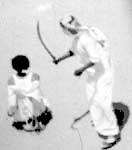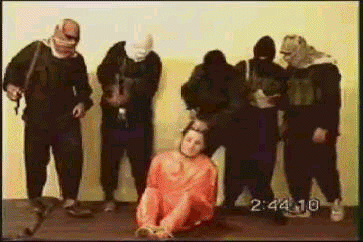Ooh, Ooh, I know, I know!




Posted on 01/10/2007 8:24:49 AM PST by kiriath_jearim
Another “think tank,” this one called the Institute for Social Policy and Understanding (ISPU), has come out for total civilian disarmament and repeal of the Second Amendment.
What’s new about that? ISPU is openly pro-Muslim, and the ISPU writer is a criminal defense attorney who argues for repealing parts of the Bill of Rights.
You can read the whole article, entitled “In the Fight Against Terrorism, Some Rights Must Be Repealed,” by Junaid Afeef, on the ISPU website:
http://www.ispu.us/pages/articles/2914/articleDetailPB.html
A JPFO supporter sent us the link, and we did read the article, looking for:
a. Inaccurate “facts” b. Missing data and support for factual claims c. Tricks in shifting the context or changing the subject d. Statements of opinion presented as though they were unquestionable facts e. Insults, innuendoes and smears f. Key facts or considerations that are totally ignored g. Logic errors
We found many errors, fallacies, propaganda tricks, and an outright lie or two. When you read the piece, see how many you can find.
Or – you can go directly to our analysis and response to the article, entitled “A Muslim Writer Tells America: Drop Your Guns and Give Up" at www.jpfo.org/dropguns.pdf
We take the ISPU article apart, paragraph by paragraph. Some of the points may be familiar to you, but there are a few new twists.
Do we expect to convince ISPU or Mr. Afeef of the errors of their position? Not really. We are publishing a response so that gun owners and rights supporters can keep their intellectual guns polished and powder dry.
The enemies of the Bill of Rights come in all flavors. We can never rest, thinking that we have answered all of their challenges.
Let us know what you think after reading our response.
The Liberty Crew
'He's personally welcome to take mine.' I'll say. Molon labe buddy.
Well, the qualifications don't evidently include that you have to THINK.
That used to be the FIRST thing that Charles "Chucky-boy" Schumer would submit when Congress convened.
There was also a document called the "Declaration of Interdependence" or some such crap introduced at one time.
I have a copy of that somewhere, I'll see if I can find it.
It's with my "Combat Arms Survey" I think.
Ooh, Ooh, I know, I know!




Nah. Feed it to pigs.
They know what to do with it.

He certainly agreed with the idea, though Cooper had personally experienced several situations during which a handgun was the only weapon immediately practical or permissable, as when he travelled in Central America.
The aphorism is more properly attributed to Clint Smith, founder of the Thunder Ranch training facility, which teaches expertise with both weapons.
Like the late Col. Cooper, Smith is a former Marine.
That's a good basic beginning, though the shotgun has a limited ability against multiple opponents or those at a distance. And some ammunition can throw a considerable muzzleflash at night, which can either flashblind you or shout *throw grenade here* to those who don't like you. Get yourself a handgun for those circumstances when your longer weapons are immediately unavailable, and a rifle with much greater range than either, and you're well on your way. And get yourself three times as much ammunition as you *think* you need; a third is your immediaye working reserve, a third is for practice and training, and the rest can be used as backup as you expend any of the other, for barter, or for friends of yours less well-equipped.
You need to check out the details of the First Battle of Plevna on On 18 July 18 1877, and the following engagements, when both the Turks and the presumably Orthodox Christian Tsarist Russian forces were using single-shot rifles, the Turks Spencers, and the Russians their *Krnka* breeckloader similar to our trap-door Springfield.
Until the outnumbering Russians reached a marked point about 200 yards fromn the Turkish trenches, whereupon the Turks set their single-shots aside and picked up the nice new lever-action 1966 and 1973 Winchester rifles they'd obtained. The First Battle of Plevna ended with Russian losses of 74 officers and 2,771 men who fell in a fire fight that lasted only 15-20 minutes. They left behind on the field 17 wagons of ammunition. Turkish losses were only 12 killed and 30 wounded.
The Russians continued to attempt frontal assaults on the Turkish positions for some six days, finally running out of conscripts before the Turks ran out of ammo. And so it went until September of that year, with the final results being the annihiliation of more than a Russian Corps, more than 25,000 men, by a force of 10-15,000 Turks.
The Russian infantry accepted these losses in their usual stoic manner, but by the time they were 600-700 yards from the Turks, they began to unravel and break up into clusters. Some groups lay down to avoid the hail of lead and were goaded to their feet by their officers who valiantly urged them onwards. The concussion of Turkish rifle fire was constant and was augmented by Turkish artillery firing shrapnel shells into the Russian line. As the Turk officers called out each new range change, the riflemen adjusted their sights and poured forth more bullets in the general direction of the Russian line. The Winchesters lay next to many of them, fully loaded with 14 rounds. A box of 500 rounds was placed next to each repeating rifle, and other ammunition reserves were close at hand.
Still they came forward, these obedient Russian soldiers, until they reached a point 200 yards from the Turkish trench line, when the order was given for the Turkish artillery, to cease fire and the riflemen to pick up their Winchesters and commence rapid fire. As the Winchesters spewed forth their rapid fire fusillade of lead, Russians fell in greater numbers than before. Still they came forward, bayonets fixed, ready to impale their oppressors in the trenches. According to prior plans, the Turks stopped shooting when the Russians were about 50 yards from the trench line, and they now abandoned their first line of trenches and ran back into their second trench line, where they commenced their rifle fire all over again. The Russian advance stalled and took cover in the Turkish first line of trenches.
Prince Schachowskoi received a message that Gen. Krudner was sending a regiment to reinforce him, but they lost their way and never arrived in time to help. At 4:00 p.m., he could hold himself back no longer and ordered his remaining troops to charge the second line of trenches. The long-range Peabody-Martinis started their deadly plunging fire again, and Russians fell in large numbers as they worked their way uphill. closer to the second line. Once more the Winchesters took up the close-range fight, sending their wall of hot lead, decimating the oncoming infantry line. In a few places, Russians managed to get into the second line trenches and, surprisingly, two companies actually got into Plevna itself, but Osman threw strong reserves into these points and drove them back.
By 6:00 p.m.. both flanks of the Russians had ended their attacks, but in desperation, Gen. Krudner sent his reserves, the Serpoukhof Regiment, into action near the center. These gallant men caught plunging fire as soon as they formed up their lines, and not one got closer than 100 yards of the Turk first trench line. Their leader, General Bojerianof. was hit near the 100 yard markers and was carried back by those of his personal guard who were still unhurt.
By 7:00 p.m., the Turks had full control of their second line trenches and attacked the now retreating forces of Prince Schachowskoi. who had no men available to act as a rear guard. The Prince sent a message to Gen. Skobeleff on his left. It read, "Extricate yourself as best you can. My companies (originally 200 strong) are coming back 5 and 10 men strong!" His personal guard had all been slain, and he kept around himself a small group of Cossacks. He managed to escape back to the Russian encampment four miles north of Plevna. His remaining soldiers were literally being driven before the Turkish rifle fire, causing the Russians to abandon three artillery pieces, all their wagons and their wounded (whom the Turks killed off during the night, as they took no prisoners).
News reporters wrote "...to find another instance of a corps being so rapidly destroyed as those the Russians used here, one has to go back to some of the frightful slaughters in the wars of the First French Empire." An official Russian report stated, "Turkish rifle fire was infernal on the flanks and center and seemed to increase greatly as our men neared the trenches." Thus ended the Second Battle of Plevna. Losses were reported to be 169 officers and 7,136 men. This represents 30 percent of the 26,000 that Gen. Krudner sent into battle.
The Grand Duke Nicholas was appalled and frustrated while Czar Alexander II messaged his demand for a successful attack to eliminate the stalemate at Plevna and to get the entire army moving again on all fronts. An army of Romanians had now joined the forces that Krudner had at Plevna. Rearmed, resupplied and rested, the combined Russo-Romanian forces now numbered 80,000 men (later to increase to 150,000). These were divided into two 40,000-man groups, and one group was held back as a reserve. Those in the attacking group were ordered to move forward as close as possible and to dig entrenchments and artillery positions on the north, south and east sides of Plevna. On the morning of Sept. 7th, they commenced a massive artillery bombardment which they maintained for four and one half days until noon on September 11th.
Turkish reports stated that this cannonade was totally ineffective and caused virtually no casualties or irreparable damage to their positions. The Turks were quite correct on this matter. Infantry in zig-zag trenches 15 inches wide could not be effectively harmed by shrapnel from shells that exploded in the ground. Only a direct hit could kill and wound, and then only in that immediate trench area.
At noon, the Third Battle of Plevna started much the same way that the others had, except for one difference. The Peabody-Martinis started killing the allied reserves that were gathered a few hundred yards behind the actual line of attacking units, over 1,000 yards from the Turkish riflemen! Turkish artillery and long-ranging Peabody-Martinis cut down large numbers of allied infantry long before they managed to reach the first trench line of the Turks. As before, the Winchesters did their remarkable job at the closer ranges. It was a repeat of battles number one and two. Krudner and his ranking advisors had seemingly learned nothing from their earlier mistakes.
Disclaimer: Opinions posted on Free Republic are those of the individual posters and do not necessarily represent the opinion of Free Republic or its management. All materials posted herein are protected by copyright law and the exemption for fair use of copyrighted works.